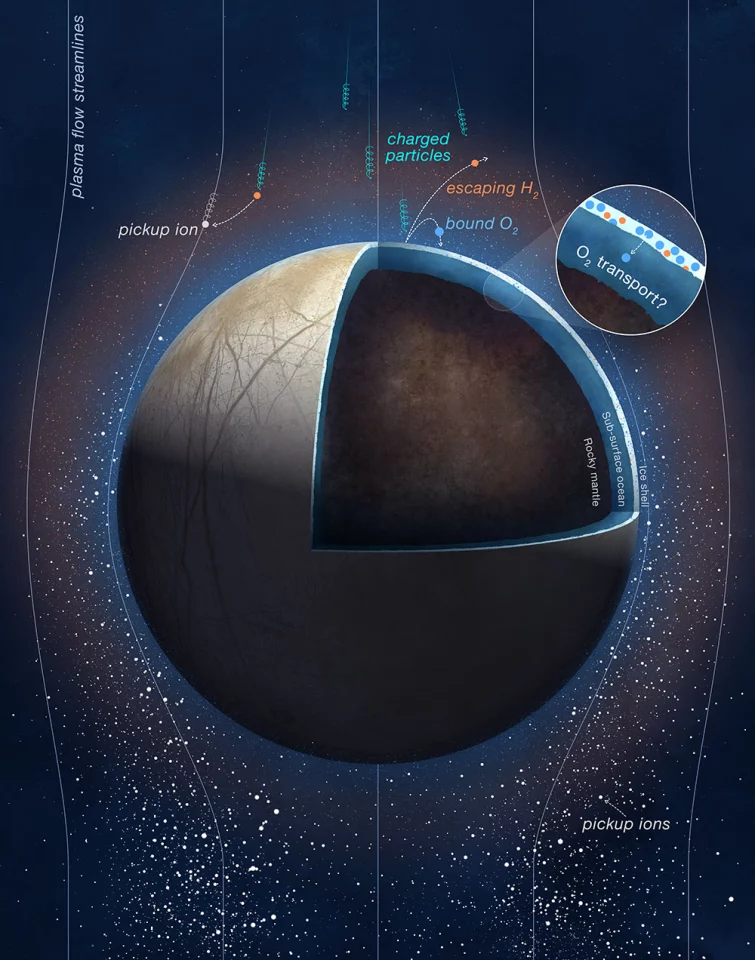Data from NASA's Juno Jupiter orbiter suggests that the Jovian moon Europa produces about 26 lb/s (12 kg/s) of oxygen or almost 100 times less than previously estimated This changes the probability of life being found in the moon's subterranean ocean.
Ever since the first Voyager missions that flew by Jupiter in 1979, there has been speculation that life may exist somewhere within the moon Europa. About 90% the size of Earth's Moon, Europa has a thick crust of ice. Based on calculations of the tidal forces working on the moon and images of the cracks and other features sent back by NASA probes, it was established that beneath the 10- to 15-mile (15- to 25-km) thick crust of surface ice, there is a global ocean 40- to 100-mi (60- to 150-km) deep.
If anything is going to get an astrobiologist's attention, it's the presence of water, which is one of the absolutely necessary conditions for life as we know it. Some in the field even talk as if it's the only condition necessary, but spontaneous generation has been out of fashion since the mid-19th century.
Instead, scientists are now looking at other factors to see if life could exist on Europa. Temperature is one. Available energy for any hypothetical life forms is another. In addition, there is salinity – too much, too little, and the right or wrong kinds of salt.

Then there is the question of the building blocks of life. To exist, life has to be able to form amino and nucleic acids. That means there has to be sufficient amounts of carbon, hydrogen, oxygen, nitrogen, phosphorus, and sulfur. Without these, no life.
That's where the Juno data comes in.
It was previously thought that Europa generates up to 2,000 lb (1,000 kg) of oxygen every second. Instead, the Juno findings place this at about 1,000 tonnes per day. According to NASa, that's enough to keep a million humans alive for a day, but for a moon of Europa's size, that's a very tiny amount of oxygen.
The measurement was made by Juno's Jovian Auroral Distributions Experiment (JADE) instrument that measures, among other things, ions of hydrogen, oxygen, and sulfur that are escaping from Europa.
Perhaps "escaping" is the wrong word. Torn from Europa is probably a better description, as the titanic magnet field of Jupiter causes the moon to be constantly bombarded with charged particles. These are slowly stripping away Europa's water by splitting the molecules into hydrogen and oxygen and blowing them away.
Unfortunately, it turns out that Europa isn't producing all that much oxygen for its ocean. That doesn't preclude the possibility of life, but it does reduce the odds, so if you're placing bets on the outcome, I would suggest putting your chips on the odds or evens part of the roulette table.
“Back when NASA's Galileo mission flew by Europa, it opened our eyes to the complex and dynamic interaction Europa has with its environment," said JADE scientist Jamey Szalay from Princeton University. "Juno brought a new capability to directly measure the composition of charged particles shed from Europa’s atmosphere, and we couldn’t wait to further peek behind the curtain of this exciting water world. But what we didn’t realize is that Juno’s observations would give us such a tight constraint on the amount of oxygen produced in Europa’s icy surface.”
The research was published in Nature Astronomy.
Source: NASA






